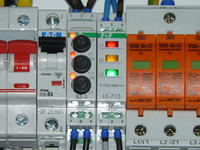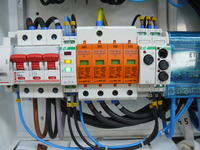In the already closed story, colleague Łukasz-O described an example of incorrect operation of the BZ-3 security and LK-713 lamps.
By connecting BZ-3 in two switchboards to two different lights (FF and Hager) I got other effects:
After removing the fuse from the BZ-3 (burnout simulation) connected to the LK-713K lamp the lamp goes on and the LED in the BZ-3 lights up .
After removing the fuse from the BZ-3 connected to the SVN129 lamp, the lamp goes out and does not light up diode in BZ-3.
So the operation of the protection is not correct, what's more, despite the connection according to the instructions (identical), the operation of both protections is VARIOUS !!!.
As I do not like to leave such situations without explanation, I contacted the Technical Department of FF. The correspondence was as follows:
FF answer:
The problem lies in the receivers themselves. Generally, LK-713 lamps are receivers that draw very low current and hence problems. In the case of F & F, we do not provide information about the protection of the lamps, because the lamp itself has protection.
I do not know what are the recommendations for lamps at Hager.
My question:
First of all, in the instructions for the FF lamp it is given that a protection should be used (eg BZ-3) in the case when the protection from the lamp is greater than 25A.
Source http://www.fif.com.pl/pub/File/download/INSTR...zniki%20zasilania/LK-713%20%20instruction.pdf
Secondly, if I pull the fuse from the BZ-3, i.e. break the circuit, how is it possible that the lamp connected for the BZ-3 still lights up?
What is the internal BZ-3 diagram that in my opinion does not work properly?
FF answer:
The light in the BZ-3 lights up after the insert is burned, as it is connected parallel to the fuse.
It sowed more doubts on me:
If it is connected in parallel, how is the fuse working, the current flows through it to the lamp, and if it is blown or it does not flow through the diode and the lamp should continue to glow.
And this is the case when connecting to the Hager lamp (I mistook the lights here - this is the case in LK-713)
In this case, simultaneous lighting of the diode and the lamp means that the phase is, but the lamp is not protected.
In this case (Hager), the unlit LED and the unlit light means that the protection works and the phase is missing, but it is the other way around. It is dangerous for the user who may think that the phase is gone and will be struck.
And I received from FFanswer that is important from the safety point:
It all depends on electricity. Our light LK-713 is so built that the current is small enough that it does not trigger the light-emitting diode in the protection . Apparently the current of the Hager lamp is bigger.
I agree with the Lord about security and remove this record from the instructions of the lamp. As I wrote in the first e-mail - in most cases our lights do not have to be secured with an additional fuse, but following the reasoning of our e-mail exchange - if it is, it should not be BZ-3.
EDIT - I deleted a colleague's colleague Łukasz-O, because he put it in a lower post and I formatted the post a bit to make it more readable.
Edit 2 - I corrected the post because I mistook the effects in the lights after removing the fuse.
By connecting BZ-3 in two switchboards to two different lights (FF and Hager) I got other effects:
After removing the fuse from the BZ-3 (burnout simulation) connected to the LK-713K lamp the lamp goes on and the LED in the BZ-3 lights up .
After removing the fuse from the BZ-3 connected to the SVN129 lamp, the lamp goes out and does not light up diode in BZ-3.
So the operation of the protection is not correct, what's more, despite the connection according to the instructions (identical), the operation of both protections is VARIOUS !!!.
As I do not like to leave such situations without explanation, I contacted the Technical Department of FF. The correspondence was as follows:
FF answer:
The problem lies in the receivers themselves. Generally, LK-713 lamps are receivers that draw very low current and hence problems. In the case of F & F, we do not provide information about the protection of the lamps, because the lamp itself has protection.
I do not know what are the recommendations for lamps at Hager.
My question:
First of all, in the instructions for the FF lamp it is given that a protection should be used (eg BZ-3) in the case when the protection from the lamp is greater than 25A.
Source http://www.fif.com.pl/pub/File/download/INSTR...zniki%20zasilania/LK-713%20%20instruction.pdf
Secondly, if I pull the fuse from the BZ-3, i.e. break the circuit, how is it possible that the lamp connected for the BZ-3 still lights up?
What is the internal BZ-3 diagram that in my opinion does not work properly?
FF answer:
The light in the BZ-3 lights up after the insert is burned, as it is connected parallel to the fuse.
It sowed more doubts on me:
If it is connected in parallel, how is the fuse working, the current flows through it to the lamp, and if it is blown or it does not flow through the diode and the lamp should continue to glow.
And this is the case when connecting to the Hager lamp (I mistook the lights here - this is the case in LK-713)
In this case, simultaneous lighting of the diode and the lamp means that the phase is, but the lamp is not protected.
In this case (Hager), the unlit LED and the unlit light means that the protection works and the phase is missing, but it is the other way around. It is dangerous for the user who may think that the phase is gone and will be struck.
And I received from FFanswer that is important from the safety point:
It all depends on electricity. Our light LK-713 is so built that the current is small enough that it does not trigger the light-emitting diode in the protection . Apparently the current of the Hager lamp is bigger.
I agree with the Lord about security and remove this record from the instructions of the lamp. As I wrote in the first e-mail - in most cases our lights do not have to be secured with an additional fuse, but following the reasoning of our e-mail exchange - if it is, it should not be BZ-3.
EDIT - I deleted a colleague's colleague Łukasz-O, because he put it in a lower post and I formatted the post a bit to make it more readable.
Edit 2 - I corrected the post because I mistook the effects in the lights after removing the fuse.






